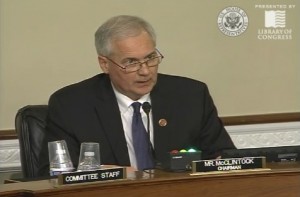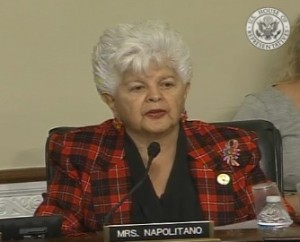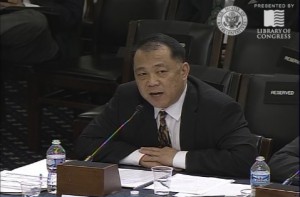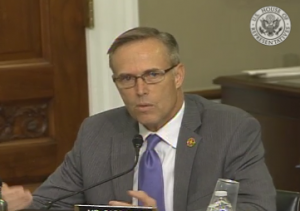On October 29th, 2013, the House Subcommittee on Water and Power held on oversight hearing, A Road Map for Increasing Our Water and Hydropower Supplies: The Need for New or Expanded Multi-purpose Facilities. The hearing, led by Subcommittee Chairman Tom McClintock (R-CA), focused on the benefits of storage projects, especially newer high-elevation storage projects as a a hedge against the effects of climate change; a point of discussion throughout the hearing was whether new storage projects were held up by regulatory processes or lack of funding.
 “During the first two-thirds of the 21st century, local, state and federal governments devoted themselves to the development of the vast, untapped water resources of the western U.S. Yet in the 1970s, this positive and forward looking policy was abandoned in favor of increasingly restrictive environmental demands,” said Congressman Tom McClintock in his opening statement. “We’ve now lived under these policies for more than 4 decades and as a result, we face increasingly severe water and electricity shortages, spiraling water and electricity prices, devastated farms, and a chronically declining economy.”
“During the first two-thirds of the 21st century, local, state and federal governments devoted themselves to the development of the vast, untapped water resources of the western U.S. Yet in the 1970s, this positive and forward looking policy was abandoned in favor of increasingly restrictive environmental demands,” said Congressman Tom McClintock in his opening statement. “We’ve now lived under these policies for more than 4 decades and as a result, we face increasingly severe water and electricity shortages, spiraling water and electricity prices, devastated farms, and a chronically declining economy.”
Mr. McClintock cited the reason for the lack of new storage projects was over-regulation. “There’s no shortage of economical storage sites,” he said. “Financing’s never been a problem for projects that produce abundant water and power. Experience shows us such projects paid for themselves many times over. What we suffer is a superabundance of bureaucracy and a catastrophic shortage of vision and political will. That is what has to change.”
Congressman Scott Tipton (R-CO) agreed. “Increasing water storage is critical as the natural cycle of rivers in the west is one of boom and bust, surplus and drought,” he said. “Streamlining the regulatory permitting process is just one way to be able to reduce the ills associated with this cycle and can help better prepare those communities that rely on snowpack to support local economies.”
“The growing west needs new water projects and the federal government should be fostering a regulatory environment that encourages new surface storage production rather than stifling these efforts,” continued Mr. Tipton. “Unfortunately, in too many instances, this is not the case.”
 Congresswoman Napolitano (D-CA) pointed out that there are other options to be considered besides new surface storage. “If we’re looking for solutions to our water problems and for certainty for our communities, then we must all have full consideration of all other options, including storage and other alternatives such as desalination and recycling,” she said. “Not all of the water needs in the west can or should be met by new dams or bigger dams.”
Congresswoman Napolitano (D-CA) pointed out that there are other options to be considered besides new surface storage. “If we’re looking for solutions to our water problems and for certainty for our communities, then we must all have full consideration of all other options, including storage and other alternatives such as desalination and recycling,” she said. “Not all of the water needs in the west can or should be met by new dams or bigger dams.”
Ms. Napolitano disagreed that regulations were holding up new storage projects. “The biggest impediment to dam construction is limited federal funding. New storage when appropriate is not impossible; California has added 5.6 million acre-feet in new groundwater and surface water storage in the last 20 years,” said Ms. Napolitano, citing the examples of Contra Costa Water District’s expansion of Los Vaqueros Reservoir and Metropolitan Water District’s Diamond Valley Lake, which were done with little or no federal funding.
“I’m not aware of a single dam, at least in California, maybe throughout the west, that actually has the financing in place to happen, and is being held up because of environmental requirements,” said Congressman Jared Huffman (D-CA). He agreed the problem is more financial rather than regulatory. “There have been huge new surface storage projects that have come online in California, but the secret to making them happen is that people didn’t put their hand out and ask for huge federal subsidies. They actually found beneficiaries that were willing to pay for those projects, and guess what, the environmental laws didn’t stop them.”
“There’s all sorts of water that we can be making available for all the beneficial uses that I know we all care about if we focus on creative strategies and the realities and the finances of water management, instead of bringing out the old dogma about environmental laws and new dams being something that would happen in the absence of the Endangered Species Act,” said Mr. Huffman.
During the witness testimony, dairy farmer Tom Barcellos testified that expanded storage in California would be hugely beneficial right now, noting that the Bureau of Reclamation and others have identified nearly 1000 potential hydroelectric and water supply projects that have been studied but not constructed. “Water resources are available to be developed,” he said.
Farmers are doing all that they can to save water, but this cannot be expanded indefinitely without further reducing acreage in production, Mr. Barcellos continued. “We continue to push improved water storage and conveyance infrastructure to mitigate for water that’s been reallocated away from agriculture,” he said. “Without water supply reliability for irrigated agriculture through a combination of new infrastructure and other supply enhancements along with efforts in demand management, our county’s ability to feed and clothes itself, and with the world, will be jeopardized.”
 Hydrologist Robert Shibitani from Sacramento spoke of the benefits of new high-elevation storage, reservoirs which are built above existing state and federal facilities during his testimony. He said that the higher-elevation facilities would be built where the snow accumulates and where population displacement and construction-related effects are minimized, they are also located far from outflow locations with many interceding reservoirs and are therefore largely unaffected by downstream water quality requirements, and they can have downstream flood control benefits as well.
Hydrologist Robert Shibitani from Sacramento spoke of the benefits of new high-elevation storage, reservoirs which are built above existing state and federal facilities during his testimony. He said that the higher-elevation facilities would be built where the snow accumulates and where population displacement and construction-related effects are minimized, they are also located far from outflow locations with many interceding reservoirs and are therefore largely unaffected by downstream water quality requirements, and they can have downstream flood control benefits as well.
“From an endangered species perspective, high elevation storage provides additional cold water pool reservoir assets that are very important for instream thermal management,” he said. “There are many emerging studies that are confirming that those facilities provide an effective adaptation to the effects of climatic change brought about by either warming temperatures or a change in precipitation form.”
California has about 120 million acre-feet of water that’s not touched by our water management practices, and of that, about 22 million acre-feet could potentially be captured, said Mr. Shibitani. “About 15 million acre-feet that leaves through the north Coast and there’s about 7 million acre-feet a year that leaves through the Golden Gate, so you’ve got 22 million acre-feet of outflow – that’s riverine outflow – that’s going out to the ocean as lost runoff,” he said. “That un-captured flow is the water that I want to serve as a foundational basis for new water storage development.”
 Congressman Huffman pointed out that the water Mr. Shibitani is talking about serves many other purposes, such as dilution of wastewater treatment plant discharges, and flows to help migrating and spawning salmon, as well as does other critical functions an ecosystem cannot function without. Furthermore, he pointed out that riparian users with downstream water rights and hydropower generation would also be impacted. “California is a state that’s already allocated all of its water,” said Mr. Huffman.
Congressman Huffman pointed out that the water Mr. Shibitani is talking about serves many other purposes, such as dilution of wastewater treatment plant discharges, and flows to help migrating and spawning salmon, as well as does other critical functions an ecosystem cannot function without. Furthermore, he pointed out that riparian users with downstream water rights and hydropower generation would also be impacted. “California is a state that’s already allocated all of its water,” said Mr. Huffman.
“It’s allocated its water at certain times of the year,” responded Mr. Shibitani. “If you go to the State Water Board, and ask if that particular river overallocated, they will say from April to September, yes, but November through March, perhaps no.”
Congressman Tipton asked Mr. Shibitani what he thought the impediment to building the new facilities was. “I clearly feel today that the overlapping and almost redundant layers in certain environmental regulations that we’re currently operating under is scaring away a lot of investors,” said Mr. Shibitani. “They are going to wait until all those permits and approvals are in place before they are ready to sign that check.”
“I’m told if there was just some certainty in outcome, that private sector financing for these projects would be abundant and there would be no need for putting taxpayers at risk on any of this,” said Mr. McClintock. “The risk would be borne by private investors.”
“I don’t want to leave the impression that I am not supportive of these various important environmental regulatory oversight processes, but let’s face it. NEPA, CEQA, ESA – they were developed 30, 40 years ago,” continued Mr. Shibitani. “Other things have changed. These regulations haven’t.”
At the close of the hearing, Mr. McClintock spoke of his desire to work on new legislation to address the regulatory delays. “It’s not financing, it’s not suitable sites, it’s not engineering,” he said. “It’s government regulatory delays that are at the root of our problem.”
For more information:
- View all meeting materials, witness statements and hearing video by clicking here.
Written by Chris “Maven” Austin
You must be logged in to post a comment.